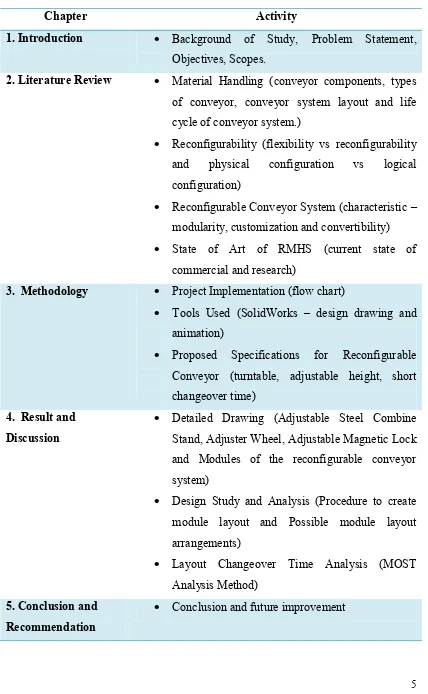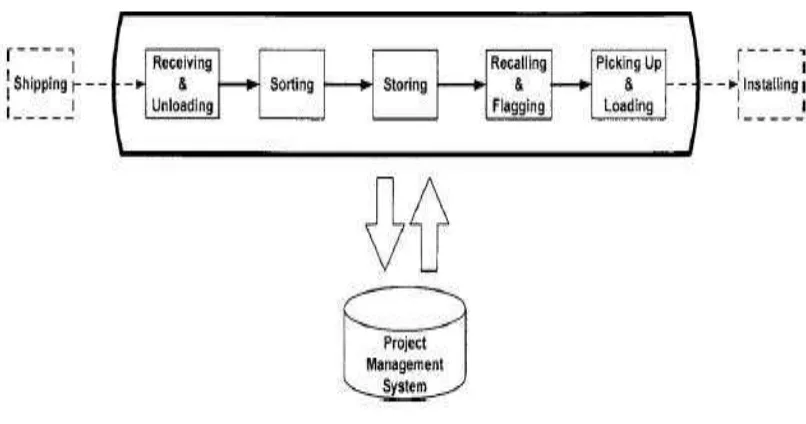UNIVERSITI TEKNIKAL MALAYSIA MELAKA
DEVELOPMENT OF A CONCEPT FOR PHYSICAL
RECONFIGURABLE CONVEYOR SYSTEM
This report submitted in accordance with requirement of the Universiti Teknikal Malaysia Melaka (UTeM) for the Bachelor Degree of Manufacturing Engineering
(Robotics & Automation) (Hons.)
by
ONG FUI YEE B 051110187 910921-05-5448
2
TAJUK: Development of a Concept for Physical Reconfigurable Conveyor System
SESI PENGAJIAN: 2014/15 Semester 2
Saya ONG FUI YEE
mengaku membenarkan Laporan PSM ini disimpan di Perpustakaan Universiti Teknikal Malaysia Melaka (UTeM) dengan syarat-syarat kegunaan seperti berikut:
1. Laporan PSM adalah hak milik Universiti Teknikal Malaysia Melaka dan penulis. 2. Perpustakaan Universiti Teknikal Malaysia Melaka dibenarkan membuat salinan untuk
tujuan pengajian sahaja dengan izin penulis.
3. Perpustakaan dibenarkan membuat salinan laporan PSM ini sebagai bahan pertukaran antara institusi pengajian tinggi.
4. **Sila tandakan ( )
UNIVERSITI TEKNIKAL MALAYSIA MELAKA
BORANG PENGESAHAN STATUS LAPORAN PROJEK SARJANA MUDA
SULIT
TERHAD
TIDAK TERHAD
(Mengandungi maklumat yang berdarjah keselamatan atau kepentingan Malaysia sebagaimana yang termaktub dalam AKTA RAHSIA RASMI 1972)
(Mengandungi maklumat TERHAD yang telah ditentukan oleh organisasi/badan di mana penyelidikan dijalankan)
DECLARATION
I hereby, declared this report entitled ―Development of a Concept for Physical Reconfigurable Conveyor System‖ is the results of my own research except as
cited in references.
Signature : ……….
Author’s Name : ……….
APPROVAL
This report is submitted to the Faculty of Manufacturing Engineering of UTeM as a partial fulfillment of the requirements for the degree of Bachelor of Manufacturing Engineering (Robotics and Automation) (Hons.). The member of the supervisory is as follow:
i
ABSTRAK
ii
ABSTRACT
iii
DEDICATION
To my beloved parents, lecturers and friends whose have guided and inspired me through this education journey and also thanks to their fully support, belief and
iv
ACKNOWLEDGEMENT
I would like to thank you for all who have helped in completing this report. A very special thanks to my kind and helpful supervisor Dr.-Ing. Azrul Azwan Bin Abdul Rahman for his guide and willingness to share his knowledge. Besides that, it would not have been possible without the kind and fully support from my beloved parents. Gratitude to all my friends for the support and sharing of knowledge and partially anticipated in this project. I would like to extend my sincere thanks to all of them.
v
2.1.1 Material Handling Equipment-Conveyor 7
vi
2.1.3.4 Turntable 16
2.1.4 Conveyor System Layout 16
2.1.5 Life Cycle of Conveyor System 18
2.2 Reconfigurability 20
2.2.1 Differentiate between Flexibility and Reconfigurability 21 2.2.2 Comparison of Physical Configuration and Logical Configuration 22
2.3 Reconfigurable Conveyor System 23
2.3.1 Characteristic 23 2.4.1.1 Reconfigurable Modular Conveyor 25
2.4.1.2 Modular Conveyor System 26
2.4.1.3 Model-driven Performance Analysis of Reconfigurable
Conveyor Systems used in Material Handling Applications 27 2.4.1.4 Reliability Evaluation of Reconfigurable Conveyor
Systems 27
3.3 Proposed Specifications for Reconfigurable Conveyor System 34
3.3.1 Pneumatic Cylinder with Turntable 34
3.3.2 Adjustable Height 35
3.3.3 Short Changeover Time 36
3.3.4 Modularity 36
vii
CHAPTER 4: RESULT AND DISCUSSION 38
4.1 Detailed Drawing 38
4.1.1 Adjustable Steel Combine Stand 39
4.1.2 Adjuster Wheel 39
4.1.3 Magnet Locking Mechanism 40
4.1.4 Modules of The Reconfigurable Conveyor System 42 4.1.4.1 Module 1 - Pneumatic Cylinder With Turntable 43 4.1.4.2 Module 2 - Single Straight Line Belt Conveyor 44
4.2 Design Analysis And Discussion 45
4.2.1 Procedure to Create Module Layout 45
4.2.2 Possible Module Layouts of Reconfigurable Conveyor System 46
4.3 Layout Changeover Time Analysis 50
4.3.1 MOST Analysis 55
4.4 Real Life Applications of The Concept for Reconfigurable Conveyor
System 60
viii
LIST OF TABLES
1.1 Activities of the project for five chapters. 5
2.1 Comparison of system features for RMS and FMS 22
4.1 Specifications of different types of magnet 41
4.2 Features of NdFeB magnet 41
4.3 Detail information of NdFeB magnet 42
4.4 Specifications of pneumatic cylinder with turntable 44
4.5 Comparison between existing conveyor system and conceptual
reconfigurable conveyor system 54
4.6 The sequence model and phases of the general move and tool use
with their parameters 55
4.7 MOST analysis of the existing conveyor system 56
4.8 MOST analysis of the conceptual reconfigurable conveyor system 57
4.9 Comparison of the total time needed to assembly the L-shape layout
between the existing conveyor system and conceptual
reconfigurable conveyor system 59
ix
2.13 Cylinder with Turntable 16
2.14 Single Line Layout 18
2.15 U-Shape Layout 18
2.16 Closed Loop Layout 18
2.17 Conventional Life Cycle of Conveyor System 19
2.18 Life Cycle of Reconfigurable Conveyor System 20
x
2.20 Modular Conveyor System 26
3.1 Overall Flow Chart of The Project 31
3.2 Example of SolidWorks Software. 33
3.3 Example of Time Based Motion Analysis 34
3.4 Adjustable Steel Combine Stand 35
4.1 Design drawing of adjustable steel combine stand. 39
4.2 Design drawing of adjuster wheel 40
4.3 Adjustable Magnet Lock 41
4.4 Design drawing of pneumatic cylinder with turntable 43
4.5 Design drawing of single straight line belt conveyor 45
4.6 Overall procedures to create module layout 46
4.7 Straight line layout arrangement 47
4.8 L-shape layout arrangement 48
4.9 U-shape layout arrangement 48
4.10 Closed loop layout arrangement 49
4.11 Full assembly layout arrangement 50
4.12 The changeover layout operations flow chart of the conceptual
reconfigurable conveyor system 52
4.13 The changeover layout operations flow chart of the
xi 4.14 Support stand and the locking mechanism of the
xii
LIST OF ABBREVIATIONS, SYMBOLS AND
NOMENCLATURE
AGV - Automated Guided Vehicle
CAD - Computer Aided Design
CAE - Computer Aided Engineering
FMHS - Flexible Material Handling System
FMS - Flexible Manufacturing System
DMS - Dedicated Manufacturing System
RMS - Reconfigurable Manufacturing System
MCE - Modular Conveyor Express
PSM - Projek Sarjana Muda
RMHS - Reconfigurable Material Handling System
vs - Versus
MOST - Maynard Operation Sequence Technique
TMU - Time Measurement Unit
1
CHAPTER 1
INTRODUCTION
This chapter gives an overview about this project entitled ―Development of a Concept for Physical Reconfigurable Conveyor System‖. Problem statement, objectives, scopes and thesis structure will be discussed in the following section.
1.1 Background of study
2 Reconfigurability, the ability to change and rearrange the behaviors of a system by only changing its configuration in a cost-effective way (Setchi et al., 2004). This new engineering technology able to react and change. Reconfigurable conveyor system has the ability to arrange n rearrange a wide variety of module with different layout by the engineer without any additional cost for purchase a brand new conveyor and losing the conveyor’s behaviors. It can be reconfigured over and over again (Jill Batka, 2011). Timm Ducey (2011) states that a truly reconfigurable conveyors are likes LEGOs which provide ultimate reconfigurability. We cannot mess up the reconfigurable systems actually. The changes of a reconfigurable conveyor can be made simply by just swapping out the modules with the release of a few bolts and nuts and snapping the modules in or out (Jill Batka, 2011). A reconfigurable conveyor system is comprised from the combination of physical and logical configuration. Physical conveyor unit is the hardware of the conveyor such as conveyor components, conveyor types, and system design layout whereas logical conveyor unit is the controller which control the movement of the transport item through the conveyor system (Wentzel et al., 2012).
1.2 Problem Statement
3 maintenance costs. A concept for this reconfigurable conveyor system need to be developed.
1.3 Objectives
To develop a concept of physical reconfigurable conveyor system.
To model and verify a reconfigurable conveyor system concept by using experimental or Computer Aided Engineering (CAE) software.
1.4 Scopes
The scopes of this project are :
a) To study and understand the concept of reconfigurable conveyor system especially in the concept of physical reconfiguration.
b) Focus on the study and understanding of belt conveyor.
c) The design of the concept for the physical reconfigurable conveyor system is going to be model and verify by using design and CAD software.
d) The proposed specifications of the layout changeover time is going to analyse by using predetermined time system method – MOST analysis method.
1.5 Thesis Structure
5 Table 1.1: Activities of the project for five chapters.
Chapter Activity
1. Introduction Background of Study, Problem Statement, Objectives, Scopes.
2. Literature Review Material Handling (conveyor components, types of conveyor, conveyor system layout and life cycle of conveyor system.)
Reconfigurability (flexibility vs reconfigurability and physical configuration vs logical configuration)
Reconfigurable Conveyor System (characteristic – modularity, customization and convertibility) State of Art of RMHS (current state of
commercial and research)
3. Methodology Project Implementation (flow chart)
Tools Used (SolidWorks – design drawing and animation)
Proposed Specifications for Reconfigurable Conveyor (turntable, adjustable height, short changeover time)
4. Result and Discussion
6
CHAPTER 2
LITERATURE REVIEW
The literature review undertaken as a part of development of a concept of physical reconfigurable conveyor system project. This project was focused on material handling especially conveyor, system reconfigurability, characteristic of reconfigurable conveyor system and current state of the art reconfigurable material handling system (RMHS).
2.1 Material Handling
7 Figure 2.1: A simple example of material handling system.
2.1.1. Material Handling Equipment – Conveyor
Material handling equipment normally is used for the storage and movement of material within a facility or manufacturing industry. Material handling equipment can be classified into five major categories which are transport equipment, positioning equipment, unit load formation equipment, storage equipment and identification and control equipment (MHE Taxonomy, 1999). The availability of manual, semi-automated and fully automated material handling equipment and technologies able to support the material handling equipment which include conveyors, industrial robot, Automated Guided Vehicle (AGVs) and others (MHI, 2014).
8 products or goods throughout a manufacturing or distribution facility. Conveyors can be horizontal, inclined or vertical which are powered by hydraulic or pneumatic or electric power. Conveyors are especially useful in applications which involve in the transportation of heavy or bulky materials. Conveyors have the ability to reduce labor costs by eliminating non-value-added travel time because they enable large quantity of materials to be moved rapidly through a process or facility (MHI, 2014). Conveyors consist of several types with different system layout.
2.1.2 Conveyor Components
2.1.2.1 Conveyor Belt
Belt is an important component for a conveyor system which made up of one or more layer of rubber. Belt normally combined with two or more pulleys with continuous and closed loop as carry medium. The belt will move and the material on the belt will move forward also when one or both of the pulleys are powered. The powered pulley is called the drive pulley where the unpowered pulley is called the idler pulley.

